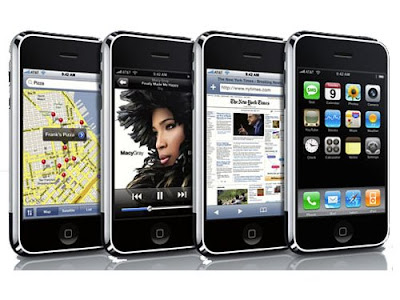 The iPhone is a lovely device with a sleek interface, top-notch music and video features, and innovative design touches. The touch screen is easier to use than we expected, and the multimedia performs well. But a host of missing features, a dependency on a sluggish EDGE network, and variable call quality--it is a phone after all--left us wanting more.
The iPhone is a lovely device with a sleek interface, top-notch music and video features, and innovative design touches. The touch screen is easier to use than we expected, and the multimedia performs well. But a host of missing features, a dependency on a sluggish EDGE network, and variable call quality--it is a phone after all--left us wanting more.The good: Stunning display; sleek design; innovative multitouch user interface; Safari browser makes for a superb Web surfing experience; offers easy-to-use apps; as an iPod, it shines.
The bad: Variable call quality and lacks some basic features found in many cell phones, including stereo Bluetooth support and 3G compatibility; integrated memory is stingy for an iPod, and you have to sync the iPhone to manage music content.
Design
On with the review: The iPhone boasts a brilliant display, trim profile, and clean lines (no external antenna of course), and its lack of buttons puts it in a design class that even the LG Prada and the HTC Touch can't match. You'll win envious looks on the street toting the iPhone, and we're sure that would be true even if the phone hadn't received as much media attention as it has.
We knew that it measures 115mm tall by 61mm wide by 11.6mm inch deep, but it still feels smaller than we expected when we finally held it. In comparison, it's about as tall and as wide as a Palm Treo 755p, but it manages to be thinner than even the trend-setting Motorola RAZR. It fits comfortably in the hand and when held to the ear, and its 135g give it a solid, if perhaps weighty, feel. We also like that the display is glass rather than plastic.
Display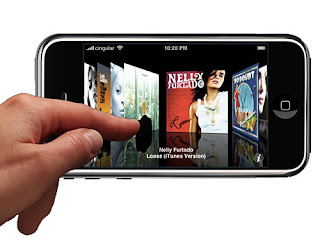
The iPhone's display is the handset's design showpiece and is noteworthy for not only what it shows, but also how you use it. We'll start off with its design. At a generous 3.5 inches, the display takes full advantage of the phone's size, while its 480 x 320-pixel resolution (160 dots per inch) translates into brilliant colors, sharp graphics, and fluid movements.
Menus
In true Apple style, the iPhone's menu interface is attractive, intuitive, and easy to use. In the main menu, a series of colored icons call out the main functions. Icons for the phone menu, the mail folder, the Safari Web browser, and the iPod player sit at the bottom of the screen, while other features such as the camera, the calendar, and the settings are displayed above. It's easy to find all features, and we like that essential features aren't buried under random menus. Fluid animation takes you between different functions, and you can zip around rather quickly.
Touch screen
Fortunately, we can report that on the whole, the touch screen and software interface are easier to use than expected. What's more, we didn't miss a stylus in the least. Despite a lack of tactile feedback on the keypad, we had no trouble tapping our fingers to activate functions and interact with the main menu. As with any touch screen, the display attracts its share of smudges, but they never distracted us from what we were viewing. The onscreen dialpad took little acclimation, and even the onscreen keyboard fared rather well. Tapping out messages was relatively quick, and we could tap the correct letter, even with big fingers. The integrated correction software helped minimize errors by suggesting words ahead of time. It was accurate for the most part.
Still, the interface and keyboard have a long way to go to achieve greatness. For starters, when typing an email or text message the keyboard is displayed only when you hold the iPhone vertically. As a result, you can only type comfortably with one finger, which cuts down on your typing speed. Using two hands is possible, but it's pretty crowded to type with both thumbs while holding the iPhone at the same time. What's more, basic punctuation such as periods or commas lives in a secondary keyboard--annoying. If you're a frequent texter or an email maven, we suggest a test drive first.
We also found it somewhat tedious to scroll through long lists, such as the phone book or music playlists. Flicking your finger in an up or down motion will move you partway through a list but you can't move directly to the bottom or top by swiping and holding your finger. Also, the lack of buttons requires a lot of tapping to move about the interface. For example, the Talk and End buttons are only displayed when the phone is in call mode. And since there are no dedicated Talk and End buttons, you must use a few taps to find these features. That also means you cannot just start dialing a number; you must open the dialpad first, which adds clicks to the process. The same goes for the music player: since there are no external buttons, you must call up the player interface to control your tunes. For some people, the switching back and forth may be a nonissue. But for mutlitaskers, it can grow wearisome.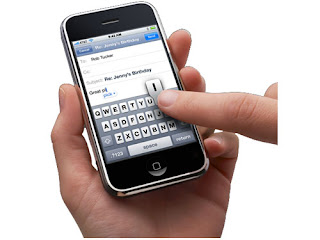
Thanks to the handset's accelerometer (a fancy word for motion sensor), the iPhone's display orientation will adjust automatically when you flip the iPhone on its side while using the music and video players and the Internet browser. Also, a proximity sensor turns off the display automatically when you lift the iPhone to your ear for a conversation. All three are very cool. We wish, however, that you could change the sleep time on the display. It goes dark after a short 30 seconds, and you must unlock it using the onscreen slide bar.
 Features
FeaturesThe iPhone's phone book is limited only by the phone's available memory. Each contact holds eight phone numbers; email, Web site, and street addresses; a job title and department; a nickname; a birthdate; and notes. You can't save callers to groups, but you can store your preferred friends to a favorites menu for easy access. You can assign contacts a photo for caller ID and assign them one of 25 polyphonic ringtones. We should note, however, that there's no voice dialing and you can't use MP3 files as ringtones. Other basic features include an alarm clock, a calculator, a world clock, a stopwatch, a timer and a notepad. There's a vibrate mode but it's a tad light.
The calendar offers day and month views, and you can use the calendar as an event reminder or a to-do list as well. The interface is clean and simple, though inputting new appointments involves a lot of tapping. There's no week view, however. Stay tuned for a report on Outlook syncing with contacts and calendar.
Bluetooth and wireless
The iPhone offers a full range of wireless functionality with support for Wi-Fi and Bluetooth connectivity. The Wi-Fi compatibility is especially welcome, and a feature that's absent on far too many smart phones. When you're browsing the Web, the iPhone automatically searches for the nearest Internet hot spot. Bluetooth 2.0 is also on board, which delivers faster transmission and a longer range than Bluetooth 1.2. You also get a range of profiles including file transfer, but an A2DP stereo Bluetooth profile is not among them--another item that's not necessary but would be nice to have.
Though Apple CEO Steve Jobs has explained the iPhone's lack of 3G support by saying the chipsets take up too much room and drain too much battery, we'd like the option anyway. Yes, the Wi-Fi network is great when you can get it, but AT&T's EDGE network just doesn't cut it for all other surfing. EDGE Web browsing is so slow, it almost ruins the pretty Web interface. More on this to come.
Messaging and email
For your messaging needs, the iPhone offers text messaging and email. As on many smart phones, a text message thread is displayed as one long conversation--a useful arrangement that allows you to pick which messages you'd like to answer. If you use another function while messaging, you can return to pick up that message where you left off. We just don't understand, however, why Apple doesn't include multimedia messaging. Sure, you can use email to send photos, but without multimedia messaging you can't send photos to other cell phones--pretty much the entire point of a camera phone.
The iPhone's email menu includes integrated support for Yahoo, Gmail, AOL, and Mac accounts. You can set up the phone to receive messages from other IMAP4 and POP3 systems, but at the time of this writing, corporate Exchange server compatibility is unclear. Check back in the next couple days for a full report. You can read--but not edit--PDF, JPEG, Word, and Excel documents. Worse: You can't cut and paste text when composing messages.
iPhone's iPod
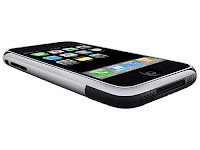
Sandwiched between all the iPhone's features lives Apple's most amazing iPod yet. The display, interface, video quality, audio quality--all of it is meticulously refined and beautiful. Unfortunately, it's trapped within a device that will cost you more than US$1,000 a year just to own. The iPhone is an exciting glimpse into what Apple hopefully has planned for its sixth-generation iPod. Apple has redeemed itself following the Motorola ROKR E1 debacle.
On paper, the iPhone's iPod doesn't offer any features not already on a fifth-generation iPod: Podcasts, videos, music, and playlists are all here, and content management with iTunes is identical. The difference rests entirely in the iPhone's interface. We've used other MP3 players that use touch interfaces, such as the Archos 704, iRiver Clix and Cowon D2, but the iPhone's unique integration of multitouch technology and a graphic user interface put it in a category all its own.
From an iPod perspective, Apple's biggest triumph with the iPhone is the fact that it has returned album artwork back into the music experience in a way that goes beyond a token thumbnail graphic. Physically flipping through your music collection in the iPhone's Cover Flow mode really brings back the visceral feel of digging through a CD or record bin. It's a tough feeling to quantify, but the real music lovers out there will appreciate how well the iPhone reconnects their digital music to a form that is both visually and physically more vivid. Even iTunes users who may already be jaded about using the Cover Flow mode on their personal computer will be surprised at how the experience is changed by using the iPhone's gesturally intuitive touch screen.
Truth be told, there is one feature that is new to the iPhone's iPod--the integrated speaker. While the iPhone's speaker sounds thin and is prone to distortion, it works in a pinch for sharing a song with a friend. Apple was also smart enough to manage its speaker volume independent of the headphone volume, so if you're listening to the speaker full-blast and then decide to plug in your headphones, you won't be deafened.
The bad news is that the iPhone's iPod leaves out the ability to manually manage the transfer of music and video content. Unlike any previous iPod, the iPhone does not allow an option for manually dragging and dropping content from an iTunes library directly to the iPhone device icon. Instead, the iPhone strictly uses defined library syncing options for collecting and syncing content from your iTunes library to the device. This should work out fine for most people, but for a device with limited memory the inability to manually manage content seems like a misstep. Our 8GB iPhone was already a quarter full after only a few hours of testing, giving us the impression that users will need to be vigilant at grooming their iPhone library. An external memory card slot is another one of those "nice to have" features.
The iPhone's music sound quality seems right in line with our experience using the 5G iPod. All the same EQ presets are available, only now they are found on the iPhone's main Settings tab. The included iPhone earbuds did a passable job for casual listening in a quiet environment. Unfortunately, the iPhone's recessed headphone jack prevented us from using many of the test headphones we're familiar with. We were just barely able to squeeze the plug of our Etymotic ER6i earphones into the jack to do the comparison.
Watching video on the iPhone is not quite as luxurious as a Creative Zen Vision W or Archos 504, but its wide screen and bright contrast beat the fifth-generation iPod by a mile. As with previous iPods, video playback is automatically bookmarked so that playback resumes where you left off. And because the iPhone is a phone it includes an airplane mode that will keep the music player activated while turning off the call transmitter.
Safari browser
The Safari browser really sets the iPhone apart from the cell phone crowd. Rather than trudging through stripped-down WAP pages with limited text and graphics, the browser displays Web pages in their true form. It's a completely and surprisingly satisfying experience to see real Web pages on a screen of this size. Our only regret is that the browser does not support Flash or Java. To pan around a page, just swipe your finger across the display, and the page moves accordingly. Tap your finger on a link to open a new page and double-tap your finger to zoom in and zoom back out. You can use the arrows on the bottom of the display to move back and forth, while a multifunction button at the bottom of the display lets you open new pages and flick among them.
Google search is the iPhone's default search tool, but you can use Yahoo search as well. When searching for information or typing URLs, you use the onscreen keyboard. It's just like typing an email except that the space bar is replaced with Web-appropriate language like ".com" and a slash. That's a nice touch.
Thanks to the accelerometer, you can tip the phone on its side for a more comfortable landscape view. It doesn't matter which direction you rotate the phone, as it will work either way. It's also nice that the onscreen keyboard appears in landscape mode when using the browser. Most Web pages looked great on the screen, but visually busy pages like CNN.com can be too crowded. And because you can zoom in only a set amount, some text can still be too small to read clearly. You can store bookmarks and sync your favorite pages from your PC, but it works only for Internet Explorer and not Firefox.
YouTube
You can activate the iPhone's integrated YouTube player straight from the main menu via a colored icon. Videos are organized using many of the same criteria on the YouTube site, including Featured Clips, Most Viewed, Top Rated, and Most Recent. You can read the information attached to a video, such as the date posted and the poster's name, but you can't read comments. It doesn't appear, however, that the YouTube connection updates in real time. We uploaded a video of our own, and it didn't show up until a few hours later.
Widgets
The iPhone doesn't have integrated GPS, but it does have a widget for accessing Google Maps. You can get directions by telling the iPhone where you are and where you want to go, but you can't get real-time directions with turns or traffic updates. The map interacts well with the calling functions as you can find a point of interest and ring it in just a few taps. We also like that you can get the Google satellite view. Stay tuned for more testing on the mapping features.
Additional widgets point to stock information and weather reports. You can program your own tickers and get information like a share gain or loss and see the chart of a share price over time. The weather function gives you a six-day forecast for your choice of cities. For more options, there is already a selection of third-party iPhone apps.
Visual voice mail
One of the most intriguing features on the iPhone is the much-touted visual voice mail. iPhone's voice mail works much like a text-message folder in that it displays the caller's name or phone number and the time. What's even more fantastic, however, is that you can listen to the message instantly by pressing the individual message--you don't have to call your voice mail first.
Camera
The iPhone's 2-megapixel camera offers a spiffy interface with a graphic that resembles a camera shutter. You're offered no camera editing options, which we didn't expect. That means you can't change the resolution, choose a color or quality setting, or select a night mode. There's no flash either, and with no self-portrait mirror, those vanity shots are going to be tricky. The camera performed well in our tests, however. Photo quality was excellent with rich, bright colors and distinct object outlines. White looked a bit too soft, but we approve overall. On the downside, you can't shoot your own video, which is disappointing on a phone at this price.
As we said earlier, the photo menu is attractive and easy to use, particularly due to the pinching motion. You can also flip between photos by swiping your finger across the display. When selecting a photo, you're given the option of assigning it to a contact, using it as wallpaper, or e-mailing it to a friend.
Call quality
We tested the quadband (GSM 850/900/1800/1900) Apple iPhone in San Francisco using AT&T service. Call quality was good for the most part, but it wasn't dependable. Though voices sounded natural, the volume was often too low, and the microphone has a sensitive sweep spot. When we moved the phone away from our ears ever so slightly, the volume diminished noticeably and we had to move the phone back to just the right place to hear clearly. The volume wasn't so bad that we weren't able to hear a friend who was in a crowded bar, but it just could be better. The speakerphone was also too quiet though conversations weren't too muffled.
The iPhone has volume problems, and a few people we called said they heard a slight background hiss. We didn't hear the hiss on our end, but more than one of our friends said they noticed it. Automated calling systems were able to understand us, but only if we were in a quiet room. On the whole, the call quality stayed the same in most environments.
Battery life
The Apple iPhone has a rated battery life of 8 hours talk time, 24 hours of music playback, 7 hours of video playback, and 6 hours on Internet use. The promised standby time is 10.4 days. When we tested the iPhone with the Wi-Fi function turned off, we got about 7 hours, 20 minutes of talk time. When we tested it with the Wi-Fi activated, we came away with 4 hours less. Video time, however, clocked in at an impressive 7.5 hours. We'll report additional test results as we get them. Just keep in mind that it's rare you'll be using just one feature for hours on end. As such, your battery life will vary widely as you switch between functions. Large color screens such as the one on the iPhone tend to be battery drainers, so you'll most likely need to charge your handset every couple of days. According to the FCC, the iPhone has a digital SAR rating of 0.974 watts per kilogram.

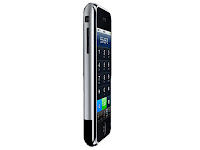





No comments:
Post a Comment